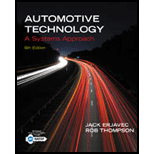
Concept explainers
- Explain staged and continuously variable value timing systems.
The explanation of staged and continuously variable valve timing systems.
Explanation of Solution
Staged variable valve timing:
Staged valve timing consists of a central camshaft, where the lobes push against the wall to open when the camshaft is rotated. Crankshaft provides input to drive cam. Both the valves can be opened when there is a single cam. In the case of two cams, one can be used for intake and the second cam is for exhaust.
Valve timing ideal value point changes with a change in rpm. It is related to engine performance and fuel efficiency.
It involves three cams with different timing and lifts profile.
Stage one- low speed.
Stage two- medium speed.
Stage three- high speed.
Example − Honda VTEC system.
Continuously variable valve timing:
Continuously variable valve timing camshaft is fitted with a phaser. It is mounted in place of timing pulley, sprocket, or gear. The principle of phaser is based on a helical gear set or vanes enclosed in a housing. When the engine is running, it helps in changing time from cam-shaft to crankshaft.
It can be electronically or hydraulic controlled.
Example − Toyota’s VVT-i system.
Want to see more full solutions like this?
Chapter 12 Solutions
Automotive Technology: A Systems Approach (MindTap Course List)
- How does a viscous clutch assembly work? Why is it used in AWD systems?arrow_forwardExplain why a height-sensing proportioning valve is required on some vehicles.arrow_forward1) What is the effect if it occurs error data reading on Throttle Position Sensors? 2) What are the effects of accelerating and slow ignition timing?arrow_forward
- Explain the role of shift rails and shift forks in theoperation of a transmission or transaxle.arrow_forwardPort timing diagram with IPO, IPC, TPO, TPC,EPO, EPC as 35,35,40,40,35,50 degrees.arrow_forwardWhat are the different input to the ECM/PCM to control the duty of a variable valve timing system?arrow_forward
 Automotive Technology: A Systems Approach (MindTa...Mechanical EngineeringISBN:9781133612315Author:Jack Erjavec, Rob ThompsonPublisher:Cengage Learning
Automotive Technology: A Systems Approach (MindTa...Mechanical EngineeringISBN:9781133612315Author:Jack Erjavec, Rob ThompsonPublisher:Cengage Learning
